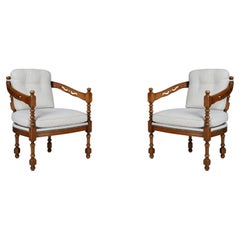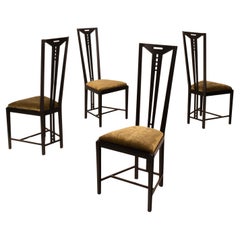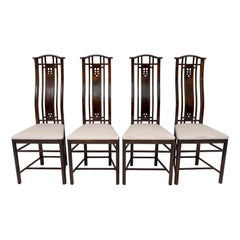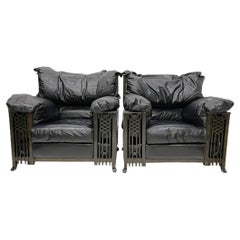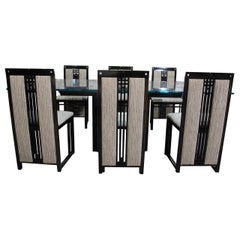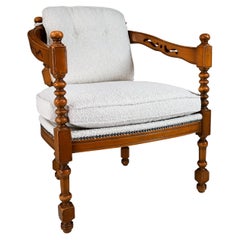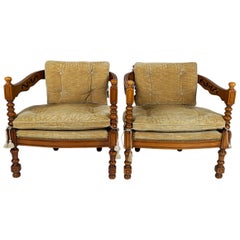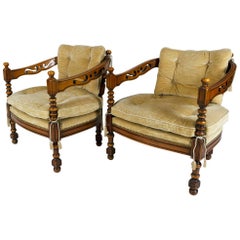Giorgetti Gallery
Giorgetti "Gallery 1975" Armchairs in Bouclé Upholstery Italy
By Giorgetti S.p.A.
Located in Almelo, NL
Giorgetti "Gallery 1975" Armchairs in Bouclé Upholstery Italy
These pair of two Giorgetti "Gallery
Category
Vintage 1970s Italian Modern Armchairs
Materials
Bouclé, Upholstery, Beech
$3,720 / set
H 33.47 in W 25.2 in D 29.53 in
Mid-Century Gallery Chairs by Asnago and Pozzi for Giorgetti, 1970's
By Ambrogio Pozzi, Giorgetti S.p.A., Umberto Asnago
Located in Conversano, IT
Ricerche Giorgetti between 1975 and 1980.
This particular version of the Gallery collection is especially
Category
Vintage 1970s Italian Dining Room Chairs
Materials
Velvet, Ash
$3,319 / set
H 45.28 in W 19.69 in D 19.69 in
Four Giorgetti Italian Dinning Armchairs "Gallery", 1980s
By Giorgetti S.p.A.
Located in Puglia, Puglia
These four chairs were made by the famous Italian company Giorgetti, the four chairs are in stained
Category
Vintage 1980s Italian Mid-Century Modern Dining Room Chairs
Materials
Velvet, Beech
$2,157 Sale Price / set
30% Off
H 44.1 in W 17.72 in D 15.75 in
Gallery Collection Chairs by Giorgetti, Model 6141/0
By Giorgetti S.p.A.
Located in Delft, NL
Gallery Collection chairs by Giorgetti, model 6141/0
2 gigantic armchairs, designed by Giorgetti
Category
20th Century Italian Armchairs
Materials
Leather, Beech
Exclusive Dining Table and Chairs “New Gallery” Modernist Giorgetti Set
By Giorgetti S.p.A.
Located in Casteren, NL
A rare and exclusive modernist dining set from the renowned Italian label Giorgetti from their “New
Category
Late 20th Century Italian Mid-Century Modern Dining Room Sets
Materials
Fabric, Glass, Beech
$16,124 Sale Price / set
20% Off
H 36.61 in W 88.19 in D 43.31 in
Giorgetti Armchair in Bouclé Wool Fabric Italy 1970s
By Giorgetti S.p.A.
Located in Almelo, NL
Iconic classical / Art Deco style arm / easy chair made in the '70s from the famous Gallery
Category
Late 20th Century Italian Art Deco Armchairs
Materials
Bouclé, Wood
Recent Sales
Pair of Giorgetti Armchairs Gallery Collection, Made in Italy, 1970s
By Giorgetti S.p.A.
Located in Enschede, Overijssel
Rare Classic Italian set of carved wood armchairs by Giorgetti with original velvet upholstery
Category
Vintage 1970s Italian Lounge Chairs
Materials
Velvet, Walnut
H 27.56 in W 25.99 in D 25.99 in
Pair of Giorgetti Armchairs Gallery Collection, Made in Italy 1970s
By Giorgetti S.p.A.
Located in Enschede, Overijssel
Rare Classic Italian set of carved wood armchairs by Giorgetti with original velvet upholstery
Category
Vintage 1970s Italian Mid-Century Modern Lounge Chairs
Materials
Velvet, Walnut
Giorgetti Armchair Gallery Collection, Italy, 1975 - Two Items
By Giorgetti S.p.A.
Located in Copenhagen, DK
Rare set of two iconic Italian easy chairs from the Giorgetti S.p.A. Gallery Collection of 1975
Category
20th Century Italian Art Deco Armchairs
Materials
Fabric, Textile, Wood
Giorgetti Italian Round Dinning Table "Gallery", 1980s
By Giorgetti S.p.A.
Located in Puglia, Puglia
specifically.
Founded by Luigi Giorgetti in 1898 in Brianza, the Italian design and furniture company
Category
Vintage 1980s Italian Modern Dining Room Tables
Materials
Beech
Pair of Giorgetti Armchairs of the 1975 Gallery Collection
By Giorgetti S.p.A.
Located in Dronten, NL
Classic Italian set of carved wood armchairs by Giorgetti with original velvet upholstery.
Marked.
Category
Vintage 1970s Italian Art Deco Armchairs
Materials
Velvet, Wood
Giorgetti Italian Round Dinning Table and Four Armchairs "Gallery", 1980s
By Giorgetti S.p.A.
Located in Puglia, Puglia
This dining table and four chairs was made by the famous Italian company Giorgetti, the table is in
Category
Vintage 1980s Italian Mid-Century Modern Dining Room Tables
Materials
Beech, Velvet
Giorgetti New Gallery Armchair with Ottoman by Umberto Asnago
By Giorgetti S.p.A., Umberto Asnago
Located in Ludwigslust, DE
A New Gallery armchair in very good condition. The fabric of the armchair, as well as the ottoman
Category
1990s Italian Post-Modern Armchairs
Materials
Fabric
1970s, Set Giorgetti Arm Lounge Club Chairs of the Gallery Collection, Italy
By Giorgetti S.p.A.
Located in Silvolde, Gelderland
the famous Gallery Collection by Giorgetti with velvet gold / amber colored original cushions.
Both
Category
Vintage 1970s Italian Art Deco Lounge Chairs
Materials
Velvet, Beech
H 25.2 in W 25.2 in D 23.63 in
1970 Italian Giorgetti Arm / Lounge Chair in Amber of the Gallery Collection 1
By Giorgetti S.p.A.
Located in Silvolde, Gelderland
Iconic classical / Art Deco style lounge / easy chair made in the '70s from the famous Gallery
Category
Vintage 1970s Italian Art Deco Lounge Chairs
Materials
Velvet, Beech
H 25.2 in W 25.2 in D 23.63 in
1970's, Italian Giorgetti Arm / Lounge Chair in Amber of the Gallery Collection
By Giorgetti S.p.A.
Located in Silvolde, Gelderland
Iconic classical / Art Deco style lounge / easy chair made in the '70s from the famous Gallery
Category
Vintage 1970s Italian Art Deco Lounge Chairs
Materials
Velvet, Beech
H 25.2 in W 25.2 in D 23.63 in
Giorgetti New Gallery Art Deco armchair with ottoman by Umberto Asnago
By Umberto Asnago, Giorgetti S.p.A.
Located in Ludwigslust, DE
The classic New Gallery armchair was designed by Asnago in the Art Deco style and is in very good
Category
1990s Italian Art Deco Armchairs
Materials
Fabric, Cherry
H 44.89 in W 32.68 in D 33.08 in
People Also Browsed
'Plissé White Edition' Pleated Textile Table Lamp by Folkform for Örsjö
By Örsjö Industri AB
Located in Glendale, CA
'Plissé White Edition' pleated textile table lamp by Folkform for Örsjö.
This unique table lamp was awarded “Lighting of the Year 2022” by Residence Magazine Sweden, who called it “...
Category
21st Century and Contemporary Swedish Mid-Century Modern Table Lamps
Materials
Textile
$1,650 / item
H 16.1 in Dm 11.5 in
Oval Brass and Parchment Chandelier by Diego Mardegan for Glustin Luminaires
By Diego Mardegan
Located in Saint-Ouen, IDF
Beautiful chandelier by Diego Mardegan for Glustin Luminaires, this other version of the spider chandelier has longer arms on the sides giving the oval shape.
The metal arms paint...
Category
2010s Italian Modern Chandeliers and Pendants
Materials
Metal, Brass
$16,829 / item
H 53.15 in W 125.99 in D 59.06 in
Bespoke Round Italian Dining Table in Travertine
Located in London, London
Travertine dining table
Made to order in Italy
Round top
Honed or polished finish
Rounded or straight edges
Travertine pedestal.
The photos show a selection of tables we have m...
Category
21st Century and Contemporary Italian Mid-Century Modern Dining Room Tables
Materials
Travertine
Dining Chairs Umberto Asnago for Giorgetti, 1980s
By Giorgetti S.p.A., Umberto Asnago
Located in Leuven, Vlaams Gewest
Elegant italian design dining room chairs designed by Umberto Asnago for Giorgetti.
The set consists of 8 high back solid wooden dining chairs with the original coloured fabric up...
Category
Vintage 1980s Italian Dining Room Chairs
Materials
Fabric, Wood
Get Updated with New Arrivals
Save "Giorgetti Gallery", and we’ll notify you when there are new listings in this category.
Giorgetti Gallery For Sale on 1stDibs
Choose from an assortment of styles, material and more with respect to the giorgetti gallery you’re looking for at 1stDibs. A giorgetti gallery — often made from wood, fabric and velvet — can elevate any home. You’ve searched high and low for the perfect giorgetti gallery — we have versions that date back to the 20th Century alongside those produced as recently as the 20th Century are available. When you’re browsing for the right giorgetti gallery, those designed in Art Deco, Mid-Century Modern and Modern styles are of considerable interest.
How Much is a Giorgetti Gallery?
Prices for a giorgetti gallery start at $1,888 and top out at $19,844 with the average selling for $2,918.
